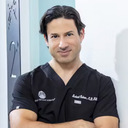Posted underGynecomastia Surgery q&a
Can True Gynecomastia (Glandular Tissues) Be Cured by Liposuction?
I have puffy nipples and I went to see a government plastic surgeon. After scanning she told me that the glandular tissue is about 2.5cm. She recommended that I skip the surgery as it is very mild. And if I really insist on doing it, it will be removed by liposuction and a "divider" to shave the tissues. No incision will be done. 1. Should I do the surgery? 2. Can liposuction really remove glandular tissues? 3. What is the size of the normal male breast tissue? 4. will there be scars?
Answers (31)
From board-certified doctors and trusted medical professionals
Dr. Jed H. Horowitz, MD, FACS

Dr. Jed H. Horowitz, MD, FACS
Board Certified Plastic Surgeon
Answer
Dr. Robert Cohen, MD

Dr. Robert Cohen, MD
Board Certified Plastic Surgeon
Answer
Dr. Jeffrey D. Wagner, MD

Dr. Jeffrey D. Wagner, MD
Board Certified Plastic Surgeon
Answer
Dr. John Nguyen, MD, FACS

Dr. John Nguyen, MD, FACS
Board Certified Plastic Surgeon
Answer
Dr. Richard J. Bruneteau, MD

Dr. Richard J. Bruneteau, MD
Board Certified Plastic Surgeon
Answer
Dr. Sean Younai, MD, FACS

Dr. Sean Younai, MD, FACS
Board Certified Plastic Surgeon
Answer
Dr. Miguel Delgado, MD

Dr. Miguel Delgado, MD
Board Certified Plastic Surgeon
Answer
Dr. York Jay Yates, MD

Dr. York Jay Yates, MD
Board Certified Plastic Surgeon
Answer
More Gynecomastia Surgery Questions
See all Gynecomastia Surgery Q&AWE SEND PRETTY
EMAILS
What’s trending? Who’s turning heads? Which TikTok myths need busting? We’ve got you. No fluff, no gatekeeping—just real talk. Get our free, unfiltered newsletter.

